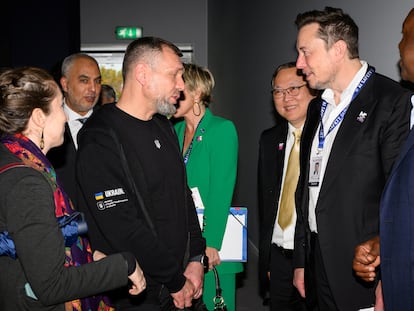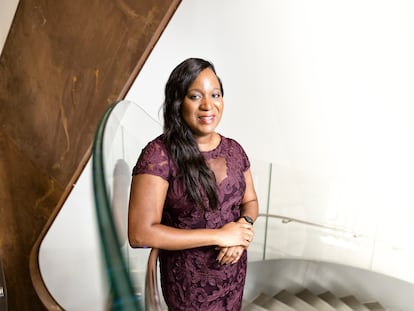‘We are entering an era that is going to lead to something incredible and profound’: AI takes over largest technology trade show
Female bullfighters that never existed, automatic doctors, ground and air vehicles and robots with human capabilities on display at Dubai’s Gitex Global
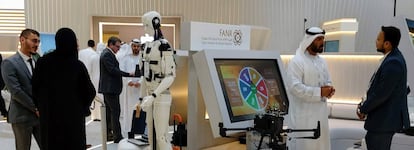
“We are entering an era that is going to lead to something incredible and profound that has never been seen before.” These are the words of Omar Bin Sultan Al Olama, a 33-year-old Dubai citizen and Minister of Artificial Intelligence in the United Arab Emirates since 2017. This was the first ministerial position in the world in this field and it is proof of the country’s commitment to this technology. It is also demonstrated at a special event: the world’s largest technology fair (Gitex Global, organized by Dubai World Trade Centre, and the Expand North Star trade show, organized by the Chamber of Digital Economy). According to the organizers, 6,000 companies from 180 countries and more than 180,000 visitors participated in this event. For the first time in its 43-year history, this exhibition, which will be replicated in Europe in Berlin from May 21 to 23, united the largest exhibition of artificial intelligence in existence, including its challenges and threats.
The Dubai minister advocates the supervision of new technology (the United Arab Emirates has signed the Bletchley Declaration) but refuses to follow protectionist lines. “We are not going to be that here. We will govern to safeguard people’s lives in the areas that matter to them,” he says, citing disinformation and hoaxes as emerging threats and championing international cooperation as a useful tool. But he advocates allowing for “the liberation of technology as a whole, rather than its confinement and restriction.”
The two exhibitions held in Dubai under the theme AI Everything accurately reflect this concept. Here are some of the most unique proposals — some of them defy the future European AI Act.
Management. This is the predominant concept in the two shows. Artificial intelligence has been inserted in all fields, ranging from education and healthcare to the creation of proprietary applications or the generation of unique and personalized IT ecosystems. It has been present in areas such as water management, armed forces, police, municipal administration, sales, industry, mining, finance and cybersecurity. Every human process is becoming more efficient. This is according to Hazem Nabih, director of technology for the Middle East at Microsoft, who says that “the productivity of any company increases between 30% and 50%” with the new technology. One of the greatest challenges relates to information, which can be subjected to unprecedented levels of manipulation because of its complexity and scope. Hazem Nabih advocates for consolidated media in the journalistic field as a pledge of reliability and ethics in the treatment of information.
One of the trends observed in Dubai is the bundling of services, as proposed by Chinthaka Athulanthmudali, a representative of ITX360. This Sri Lanka-based entity provides solutions to “increase productivity, optimize processes and drive growth” in everything from simple IT to automation and communication. All in one place.

Content generation. This is another of the key axes of artificial intelligence. Warren Leow, from Malaysia, represents Inmagine, a company originated from a database of images that has specialized in developing intelligent, fast and user-friendly design tools for any creative process. Leow, who is knowledgeable of Spain, puts one of his platforms to the test: “A female bullfighter in Seville’s Alcazar.” It dispenses with low quality images, watermarks, blurred areas, among others. The result is a non-existent woman in a fictitious scenario, but in high quality. It does the same with corporate information that includes a well-known car brand with a well-known football team. The result is grammatically and stylistically flawless. And it can combine everything to generate videos, web pages, messages on networks, and much more. Arnaud Ginioux, director of the company for southern Europe, shows some creations that have been made for major brands while it justifies the absence of barriers for the platforms, at a cost of less than €10 per month, to generate fake hyperrealistic content: “It is a tool. The responsibility is the user’s.”
Such solutions are in abundance at Gitex and some are children-oriented, like the Indian cartoon creation platform Bhooshan’s Junior, which incorporates an artificial intelligence dialogue option for direct use with children while viewing the product.
Facial recognition. This tool, which occupied a central space at the Consumer Electronic Show (CES) in Asia (Shanghai) four years ago, is advancing at a much faster pace in comparison to the regulatory intentions of the European Union, which will prohibit its indiscriminate use. At Gitex, the race for its development continues to gather pace and some companies have presented tools that “transform any camera into an intelligent observer that allows attendance control at school or at work, as well as the metrics of people’s concentrations.”
In this field, the Saudi company T2 has unveiled Availo, a system to control the working hours of employees using the Internet of Things (IoT) technique through facial or voice recognition for each employee. “All you need is a smartphone to make sure they are present and on time,” the company says.
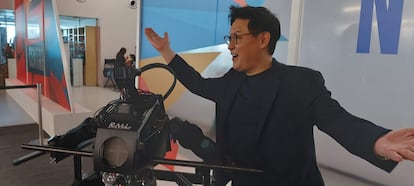
Robotics. No technology trade fair could be complete without it. Deep Robotics exhibited its quadruped models for industrial and rescue work. Vera Huang admits that the greatest advances have come from motors, including the ability to jump or climb stairs, but, in reference to the potential of artificial intelligence, she clarifies: “Programs can be incorporated into it.”
Someone who has already done this is Dennis Hong, founder of RoMeLa and creator of Artemis, the android robot that plays football as a demonstration of the versatility achieved in its movement capabilities. “99.9% of the robots out there today use servomotors and are very rigid. They are great for factory automation or single household tasks, but they can’t really be used for walking. This robot [Artemis] mimics biological muscle and that allows it to be agile, fast and very robust. It is also quite intelligent,” explains Dennis Hong.
“This robot,” adds the engineer, “does not use artificial intelligence for locomotion control. But it is intelligent in that it can recognize a good plan and make decisions autonomously. The future is that it can execute anything a human can do,” he concludes.
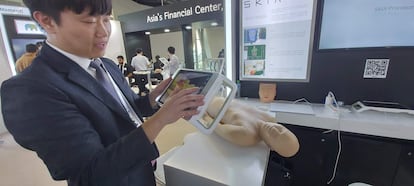
Healthcare. The Gitex Global fair showcased a variety of artificial intelligence proposals in this field, from classic hospital and healthcare management (the most abundant) or diagnostic imaging to the most innovative, such as Mand.ro’s low-cost robotic hand or Rokit Healthcare’s Invivo 3D bioprinter for tissue engineering and regenerative medicine research. One of the most unique is Skia’s “virtual autopsy” tool, which uses a patient’s data, recreates a 3D model and compares it with data from the same deceased person to provide causes of death powered by artificial intelligence.
Giants Lenovo and Intel unveiled their collaboration with Novo Genomics, a Saudi Arabian company specializing in personalized medical treatments for genetic diseases. The Lenovo Goast system can process up to 32 exomes (coding parts of genes) in under three hours.

Mobility. This is another of the many great fields of artificial intelligence. Tom McCarthy, CEO of Aspire, presented the A2RL, a driverless formula 1 model supported by artificial intelligence. McCarthy details that it can reach 300 km/h and weighs 690 kg. But while it will participate in autonomous vehicle competitions, this is not its ultimate goal. “We are creating an ecosystem to attract industry. Mobility is the future,” he explains.
The Emirati Sulmi electric motorcycle, equipped with artificial intelligence, also operates in the same field, with a 300 km range, a top speed of 155 km per hour and a 30-minute recharge time.
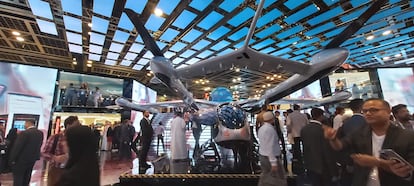
In addition to the various electric car models of the major brands, also on display in Dubai was the electric aircraft from AutoFlight Europe. This company is already conducting test flights in Shanghai with the aim of obtaining the necessary certification. First it will be used to carry cargo and, in about four years, as a model designed to carry a pilot and between two and three passengers. Once the Chinese permit is obtained, they will begin applying for it in other countries. “In Europe, we hope to be able to conduct some demonstration flights next year,” explains Jocelyn Moreau, head of the German-based company.
“The vehicle can take off and land like a helicopter and fly like an airplane to reach between 200 and 250 kilometers. We expect the price to be under €2 million,” he says.
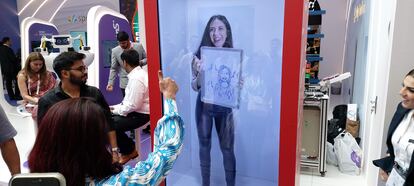
Customer services. This is another area where artificial intelligence has been introduced to provide better services. This is the case of the human-like holographic assistant equipped with artificial intelligence unveiled by Purple Go in the Dubai Digital City pavilion. Mohamed Akhdas says, “It’s a device that is already in the market.” The assistant is capable of identifying a person by their appearance, attracting their attention and holding a conversation with them, even making jokes. One of the participants in the event was lured by the hologram based on the color of her shirt and invited to have her portrait painted. After a few minutes, she laughingly presented a drawing that intentionally appeared childish, but accurately reflected the basic lines of the visitor’s image and her clothing. The extraordinary capacity for interaction can be used for any assistance service with precise indications, for sales to formalities.
Sign up for our weekly newsletter to get more English-language news coverage from EL PAÍS USA Edition
Tu suscripción se está usando en otro dispositivo
¿Quieres añadir otro usuario a tu suscripción?
Si continúas leyendo en este dispositivo, no se podrá leer en el otro.
FlechaTu suscripción se está usando en otro dispositivo y solo puedes acceder a EL PAÍS desde un dispositivo a la vez.
Si quieres compartir tu cuenta, cambia tu suscripción a la modalidad Premium, así podrás añadir otro usuario. Cada uno accederá con su propia cuenta de email, lo que os permitirá personalizar vuestra experiencia en EL PAÍS.
¿Tienes una suscripción de empresa? Accede aquí para contratar más cuentas.
En el caso de no saber quién está usando tu cuenta, te recomendamos cambiar tu contraseña aquí.
Si decides continuar compartiendo tu cuenta, este mensaje se mostrará en tu dispositivo y en el de la otra persona que está usando tu cuenta de forma indefinida, afectando a tu experiencia de lectura. Puedes consultar aquí los términos y condiciones de la suscripción digital.
More information
Archived In
Últimas noticias
ICE raids trigger school absenteeism and traumatize children: ‘They have been forced to leave their childhood behind’
Mexico’s missing people crisis casts a shadow over World Cup venue
Can cheese protect brain health? This is what the science says
Maude Apatow, from acting in ‘Euphoria’ to directing: ‘There are many films that you can tell weren’t written by someone young’
Most viewed
- Christian Louboutin: ‘Young people don’t want to be like their parents. And if their parents wear sneakers, they’re going to look for something else’
- US sanctions against jailed cartel leader ‘El Marro’ highlight Mexico’s lack of control over its prisons
- Cartels in Mexico take a leap forward with narco-drones: ‘It is criminal groups that are leading the innovation race’
- Liset Menéndez de la Prida, neuroscientist: ‘It’s not normal to constantly seek pleasure; it’s important to be bored, to be calm’
- ‘El Limones’ and the growing union disguise of Mexican organized crime

